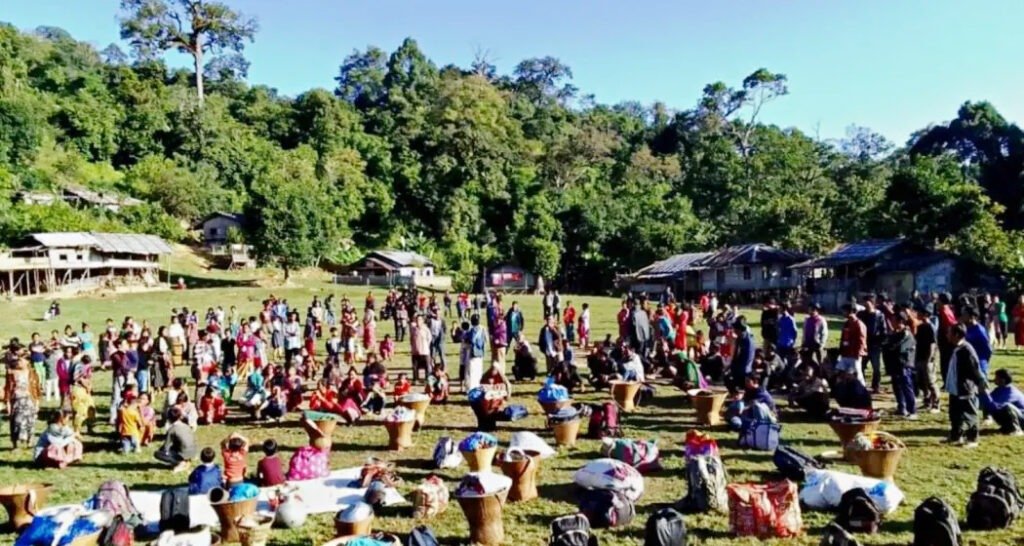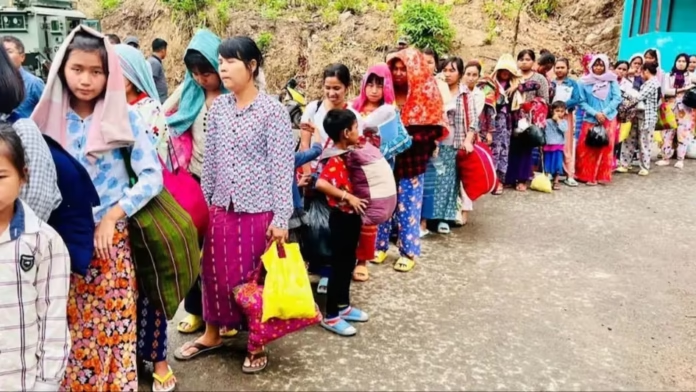In a significant humanitarian development, nearly 3,000 Myanmar refugees return home from Mizoram as border tensions ease following a recent ceasefire in Myanmar’s Chin State. The move has been welcomed as a hopeful sign for conflict-hit communities who had fled the country after years of political turmoil and violence.
Thousands Begin Journey Back Across the Border
According to Champhai district authorities, nearly 4,653 Myanmar nationals had initially taken refuge in border villages such as Zokhawthar, Saikhumphai, and Vaiphai. Most of these refugees belong to the Chin ethnic group, who share close cultural and linguistic ties with the people of Mizoram. Out of this displaced population, almost 3,000 Myanmar refugees return home in recent days, marking a major shift in refugee patterns along the India–Myanmar border.
The repatriation process began on July 7, 2025, and gathered pace after July 12, following a ceasefire agreement between the Chin National Defence Force (CNDF) and the Chinland Defence Force-Hualngoram (CDF-Hul). Officials reported that 2,923 individuals from Zokhawthar and 39 from Vaiphai returned voluntarily, while hundreds more are preparing to leave.
Ceasefire Boosts Confidence Among Refugees
Authorities and locals note that the decision of Myanmar refugees to return home is directly linked to improved ground conditions in Chin State. The ceasefire between rival groups has reduced armed clashes, giving displaced families the confidence to cross back to their villages.
Police reports indicate that over 2,300 refugees returned during a single weekend, with more following in the days after. The unfenced 510-kilometer India–Myanmar border has allowed a relatively smooth transition for those choosing to repatriate.
Mizoram’s Role as a Humanitarian Sanctuary
Since Myanmar’s military coup in 2021, Mizoram has sheltered more than 32,000 refugees across its 11 districts. Many refugees have lived in relief camps, rented houses, or with relatives, relying on the goodwill of local communities. While the recent wave of returns is encouraging, Mizoram still hosts thousands who are uncertain about their future.
Interestingly, while Myanmar refugees return home in large numbers, the state continues to receive new arrivals. Recent clashes in Chin State have forced over 700 fresh refugees into Mizoram, highlighting the unpredictable nature of the crisis.
Government Steps Up Refugee Data Collection
The Mizoram government is preparing to launch a biometric and demographic data collection drive to better manage the refugee population. This process, scheduled to begin later this month, will include both Myanmar and Bangladesh refugees. Officials say the initiative will strengthen security, improve relief distribution, and help track population movements.
Such steps are vital as Mizoram balances its humanitarian responsibilities with administrative and security concerns. With Myanmar refugees return home becoming more frequent, accurate data will also help monitor trends and prepare for future challenges.
Regional Impact and Humanitarian Outlook
Mizoram’s experience highlights the delicate balance of geography, ethnicity, and politics. The cultural bonds between Mizos and Chins have created a natural support system for those fleeing violence. Yet, as thousands of Myanmar refugees return home, it underscores the urgent need for long-term peace in Myanmar to prevent repeated cycles of displacement.

For India, the ongoing refugee situation also holds strategic implications. Managing porous borders, ensuring refugee safety, and maintaining regional stability remain top priorities for state and central governments.
Long-Term Stability Still in Question
Experts warn that while the voluntary return of thousands is a positive step, the future remains uncertain. Without political reconciliation in Myanmar, refugee movements may continue in waves. If ceasefires collapse or new conflicts erupt, Mizoram could once again face an influx of displaced families.
Nonetheless, the fact that nearly 3,000 Myanmar refugees return home marks a hopeful turning point. It shows that even in conflict-ridden regions, small steps toward peace can open the door to safety, dignity, and the possibility of rebuilding lives.
A Glimmer of Hope Amid Uncertainty
As more Myanmar refugees return home, Mizoram authorities and communities remain prepared to provide support for those who still need shelter. The latest developments highlight both the resilience of refugees and the importance of cross-border cooperation in tackling humanitarian crises.
While challenges remain, the successful repatriation of thousands demonstrates that when stability returns, even temporarily, people long to go back to their roots. For the displaced Chin population, this return home is more than just a movement across borders—it is a step toward reclaiming identity, community, and hope.
ALSO READ: Bengaluru Stampede Before RCB Victory Celebration: Ignored Police Warning Sparks Political Firestorm












